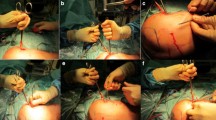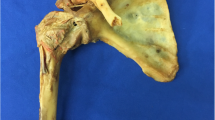Abstract
Purpose
The purpose of this study was to determine the biomechanical effects of placing the biceps tenodesis stitch at the musculotendinous junction versus in the tendon only. Placing the stitch at the musculotendinous junction was hypothesized to result in a significantly weaker repair than stitching in the tendon only.
Methods
Testing was performed on two groups of six matched pairs of long head of the biceps (LHB) with enclosed musculotendinous junction and muscle belly. Specimens were randomly distributed between two groups. The same baseball whipstitch configuration was performed using the same suture material in both groups. In group 1, the stitch configuration started 1 cm proximal of the musculotendinous junction (tendon tissue only). For contralateral specimens, the baseball whipstitching included the distal 1 cm of the musculotendinous junction. Specimens were pulled to failure at a rate of 60 mm/min. Ultimate failure load and failure pattern were recorded.
Results
Average ultimate failure load of group 2 was significantly higher than group 1 (mean increase 18.6 %, range −9.7 to 35.8 %; p = 0.046). A cut-through failure pattern was observed for all specimens in both groups. There were highly significant correlations between ultimate failure load and tendon thickness (p = 0.004, τ = 0.636), age of the specimen (p = 0.002, τ = 0.724), and gender (p = 0.004, τ = −0.739). No significant difference between the groups regarding tendon diameter was observed.
Conclusions
Baseball whipstitching of the LHB including the distal part of the tendon and the musculotendinous junction was stronger than sutures placed in the tendon alone. These results suggest that suture pattern affects initial strength of repair, and therefore may affect decisions regarding early post-operative rehabilitation or ultimate clinical outcomes. Inclusion of the musculotendinous junction should be considered clinically for improved time zero strength of the repair construct.




Similar content being viewed by others
References
Adam F, Pape D, Schiel K, Steimer O, Kohn D, Rupp S (2004) Biomechanical properties of patellar and hamstring graft tibial fixation techniques in anterior cruciate ligament reconstruction: experimental study with roentgen stereometric analysis. Am J Sports Med 32:71–78
Golish SR, Caldwell PE 3rd, Miller MD, Singanamala N, Ranawat AS, Treme G, Pearson SE, Costic R, Sekiya JK (2008) Interference screw versus suture anchor fixation for subpectoral tenodesis of the proximal biceps tendon: a cadaveric study. Arthroscopy 24:1103–1108
Jarrett CD, McClelland WB Jr, Xerogeanes JW (2011) Minimally invasive proximal biceps tenodesis: an anatomical study for optimal placement and safe surgical technique. J Shoulder Elbow Surg 20:477–480
Lafrance R, Madsen W, Yaseen Z, Giordano B, Maloney M, Voloshin I (2013) Relevant anatomic landmarks and measurements for biceps tenodesis. Am J Sports Med 41:1395–1399
Mazzocca AD, Bicos J, Santangelo S, Romeo AA, Arciero RA (2005) The biomechanical evaluation of four fixation techniques for proximal biceps tenodesis. Arthroscopy 21:1296–1306
Mazzocca AD, Rios CG, Romeo AA, Arciero RA (2005) Subpectoral biceps tenodesis with interference screw fixation. Arthroscopy 21:896
Millett PJ, Sanders B, Gobezie R, Braun S, Warner JJ (2008) Interference screw vs. suture anchor fixation for open subpectoral biceps tenodesis: does it matter? BMC Musculoskelet Disord 9:121
Nho SJ, Reiff SN, Verma NN, Slabaugh MA, Mazzocca AD, Romeo AA (2010) Complications associated with subpectoral biceps tenodesis: low rates of incidence following surgery. J Shoulder Elbow Surg 19:764–768
Nurmi JT, Sievanen H, Kannus P, Jarvinen M, Jarvinen TL (2004) Porcine tibia is a poor substitute for human cadaver tibia for evaluating interference screw fixation. Am J Sports Med 32:765–771
Patzer T, Rundic JM, Bobrowitsch E, Olender GD, Hurschler C, Schofer MD (2011) Biomechanical comparison of arthroscopically performable techniques for suprapectoral biceps tenodesis. Arthroscopy 27:1036–1047
Patzer T, Santo G, Olender GD, Wellmann M, Hurschler C, Schofer MD (2012) Suprapectoral or subpectoral position for biceps tenodesis: biomechanical comparison of four different techniques in both positions. J Shoulder Elbow Surg 21:116–125
Sakaguchi K, Tachibana Y, Oda H (2012) Biomechanical properties of porcine flexor tendon fixation with varying throws and stitch methods. Am J Sports Med 40:1641–1645
Sanders B, Lavery KP, Pennington S, Warner JJ (2012) Clinical success of biceps tenodesis with and without release of the transverse humeral ligament. J Shoulder Elbow Surg 21:66–71
Zhang Q, Zhou J, Ge H, Cheng B (2013) Tenotomy or tenodesis for long head biceps lesions in shoulders with reparable rotator cuff tears: a prospective randomised trial. Knee Surg Sports Traumatol Arthrosc. doi:10.1007/s00167-00013-02587-00168
Acknowledgments
The authors acknowledge Barry Eckhaus for the photos presented in this manuscript. The authors acknowledge Kelly Adair for his laboratory expertise. The authors acknowledge Grant Dornan for his contribution to the statistical analysis.
Author information
Authors and Affiliations
Corresponding author
Additional information
Investigation performed at the Department of BioMedical Engineering, Steadman Philippon Research Institute.
Rights and permissions
About this article
Cite this article
Spiegl, U.J., Smith, S.D., Euler, S.A. et al. Biomechanical consequences of proximal biceps tenodesis stitch location: musculotendinous junction versus tendon only. Knee Surg Sports Traumatol Arthrosc 23, 2661–2666 (2015). https://doi.org/10.1007/s00167-014-3128-9
Received:
Accepted:
Published:
Issue Date:
DOI: https://doi.org/10.1007/s00167-014-3128-9




